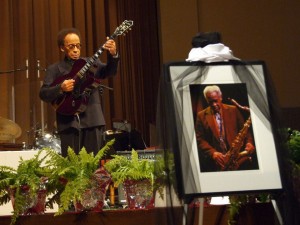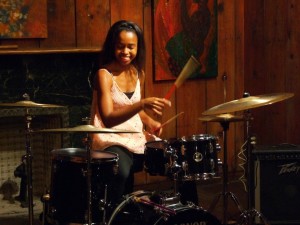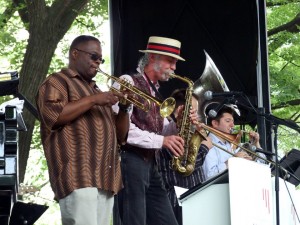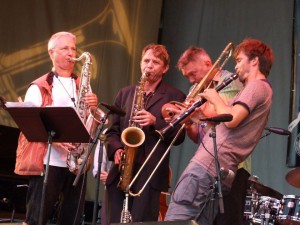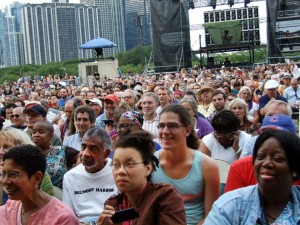Being in Chicago during the week pre-Labor Day for the City’s Department of Cultural Affairs and Special Events (DCASE)-produced, Jazz Institute of Chi-programmed Jazz Festival has been my annual habit — a good one. My hometown continues to reward broad and deep musical listening: A far-South Side “send-off” for newly departed NEA Jazz Master saxophonist Von Freeman, a city-wide jazz club tour, and the last day of three multi-stage extravaganzas downtown filled with local heroes, headlined by artist-in-resident Ken Vandermark, native son Steve Coleman, Danish guitarist-composer Pierre Dørge’s New Jungle Orchestra and New Orleans songwriter Allen Toussaint’s The Bright Mississippi show provided  a partial overview of what’s happening now.
I must mention, too, my transfer of a second batch of professional papers including ms., transcripts,
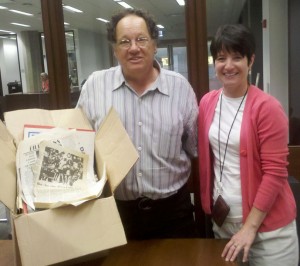
Howard Mandel contributes professional papers to Eileen Ielmini, Assistant Archives at the University of Chicago Library. Photo: JA Kawell
clippings and publications to the growing and accessible Chicago Jazz Archives in the Special Collections Research Center of the University of Chicago Library. That is an attempt to look forward, as I do not expect a memorial as public and community-endorsed as Freeman’s was. The turnout, about 600 people at the impressive Christ Universal Temple, included musicians who had worked with Von and those who had sat in with or were simply influenced by him, his son Chico, Dave Jemilo who runs the Green Mill, and his surviving brother George, a guitarist who sustains the Freeman family values of originality, generous collaboration and commitment to the Second City. Performances of identifiably South Side repertoire ranging from the bluesy songs of the hard-bop ’50s through the exploratory horns of the Association for the Advancement of Creative Musicians (AACM) alternated with emotional tributes to an 88-year-old whose sound and spirit live on.
Vonsky-like commitment is the sine qua non of the Jazz Institute, a grass roots membership organization which has guided the artistic direction of the Chi Jazz Fest  for 34 years. With no profit motive or philanthropic endowment, the JIC works with limited funds from the City, the corporate Chicago Jazz Partnership, and a dozen sponsors including the brewery Stella Artois, Pepsi, Aquafina, the Gallo Family Vineyards, the Chicago Tribune, radio station WGN, Chicago Jazz Magazine and DownBeat. The fest presents local musicians mostly in downtown outdoor settings including the Gehry-designed Pritzker Pavilion, temporary stages put up near Buckingham Fountain and the long-lasting Petrillo Bandshell, where the projected sound is considerably better than it’s complained about by Chi Trib jazz crit Howard Reich, who I think consistently confuses city’s fests apples and oranges, overlooks the participation of Chicago’s neighborhood clubs and doesn’t appreciate the unique realities reflected in this urb’s summer’s end celebration.
Prior to the Fest proper, I drove to venues from South 83rd St.’s City Life (many club tour attendees take the innovative fest-contracted trolley’s), where I again enjoyed undiscovered veteran singer June Yvon and her cool backup group, Room 43 where the Hyde Park Jazz Society holds weekly Sunday sessions; biting alto saxist Ernest Dawkins, with drummer Isaiah Spencer, who’s moving to NYC next spring, the South Side Arts Center where fast-emerging drummer Taylor Moore charmed with every broad smile and hard hit; and Joe Segal’s Jazz Showcase, where Chi multi-instrumentalist in Florida exile Ira Sullivan held forth.
In the park itself, roaring reedist Vandermark, who is a MacArthur Award winner but never has never before had a four-day artistic residency, led a couple of different ensembles; I heard his very daring electro-acoustic Made to Break quartet with synthesist Christof Kurzmann, an Austrian who resides in Argentina. Alto saxist/arranger/composer Jeff Newell was born in Nebraska and lives now in NYC, but had some years in Chicago, and led a performance of his New Trad Octet that
began with a hiply modernized version of “Struttin’ with Some Barbeque.” I could have done without unabashed pop singer Sarah Marie Young (she played tenor ukelele when no stomping and shimmying), but the Dørge Orchestra’s set was outside/inside like the best jazz, dipping into Ellington’s “Black and Tan Fantasy” and “Caravan” as well as introducing funny, gutsy originals from its latest cd, Sketches of India. They knew how to win over audience engagement, too, wiggling their fingers, leading syncopated hand-clapping and call-and-response shout-outs in Danish, then blowing their individual butts off.
Altoist Steve Coleman, a native Chicagoan mentored by Von Freeman, was even stronger, relentlessly turning cellular phrases through myriad variations — Finlayson matched Coleman’s challenging virtuosity with his own. Subsequently, Allen Toussaint was something of a comedown. Responsible for more than half the most memorable songs from New Orleans since the late ’50s — “Working in a Coal Mine,” “Yes We Can-Can,” “Voulez-vous Coucher Avec Moi,” “Java” and others written for Lee Dorsey, the Pointer Sisters, LaBelle, Al Hirt, the Dixie Cups, Meters and Neville Brothers — he flashed finesse but not much funk. Don Byron on clarinet took many chances soloing on chestnuts including “St. james Infirmary,” “A Closer Walk with Thee,” and Monk’s “Bright Mississippi” — Byron and Ribot brought the entire audience, estimated at 8 to 10,000, to a hush with Ellington’s “Solitude.” I liked this on record, but live the classicism was too laid back for a fest finale. Toussaint’s improvised piano interlude roamed through many hoary themes without spending near enough time on Professor Longhair’s rhumba-boogie.  One wag scoffed a Toussaint song with a paraphrase: “Everything I do gohn be corny from now on.”
Perhaps corn should be expected in late summer in Illinois. And there was no indication the terrifically heterogeneous audience minded sweet jazz  (the Roaring ’20s version of “smooth”) mixed with the hot. There is little to dislike, after all, about a holiday weekend of free music that appeals to the ears, minds and physical responses of so many citizens in a large and diverse metropolis. Chicago is not alone in putting on this kind of celebration of America’s indigenous musical culture — Detroit held a rival free fest last weekend, and like Chicago spotlit locals, high school and college student big bands included. But Chicago should be proud. It continues to nurture local stalwarts such as Willie Pickens, Stu Katz, Ken Cheney, Frank D’Rone and Erwin Helfer, while  continuing to turn out top level talent like alto saxist Greg Ward, drummer Mike Reed, vibist Jason Adasiewicz, trumpeter Marquis Hill, keyboardist Greg Spero, Yoko Noge and Dee Alexander, pianist Edwin Sanchez, saxophonist Caroline Davis, singer Milton Suggs. The city has a jazz feeling of its own that suffuses (as the Art Ensemble of Chicago might say) all its sounds from the ancient to the future. A lot of it swings, and much of it soars. Plus, there’s the Lake. I’m glad I grew up there.

